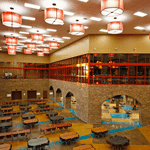The Stephens County School District, in Toccoa, Georgia, has demonstrated its commitment to energy conservation in the past decade by pursuing the Energy Star label for each of its facilities, and this initiative has produced measurable savings for the district. “Since we started the energy-management plan back in 1999, we have saved close to $6 million,” says Sherrie Whiten, superintendent of the Stephens County Board of Education.
The savings aren’t limited to the amount of energy being used. Staff and students participate in recycling programs and monitor resource consumption, and Whiten confirms that this wide-reaching approach has paid off. “We’ve been able to decrease our energy consumption while at the same time increasing our square footage,” she says.
The district’s latest construction project, a new high school, goes beyond its already progressive standards. “We started looking at LEED certification after the building was designed but before we had actually started construction,” Whiten says. First, a consultant conducted energy-modeling studies to identify potential savings opportunities and came up with 13 different models, and then up-front project expenditures were carefully weighed against life-cycle costs. “We looked at how long it would take for us to recoup that money if we made some of these changes,” Whiten says.

The new high school in Stephens County, GA, already had efficient features, but the school board saw potential for more savings through occupancy sensors, low-flow fixtures, and energy-efficient lighting.
The project was already energy efficient, but the district realized there were additional ways they could save money with the new building. “There were some things we would need to change out in order to realize additional savings,” Whiten says. A number of new design elements have helped to reduce energy consumption including occupancy sensors for the high-efficiency T5 lights, low-flow fixtures throughout the building, additional insulation to minimize energy, and a high-efficiency water-source HVAC system.
The district made sure to use local vendors and regionally sourced materials on the project, and Whiten says it also benefitted from the waste-management program, which minimizes how much material is sent to landfills, at the new facility. “We have a pulper in our cafeteria, and at the end of the day all of the food waste is reduced down to a very small cube,” she explains. When considering the scope—the high school feeds two meals each day to its nearly 1,100 students—a small cube of waste at day’s end is quite an accomplishment.
The site required the construction of a retaining wall, something Bowen & Watson, the project’s construction-management firm, carefully designed to achieve the best results while keeping costs down. Whiten says the company evaluated the first proposal for the wall and determined it would be too expensive. Their experts then crafted a new design that met the need at a more acceptable price. The final product is a pressure relief wall instead of the traditional, completely solid concrete wall. “We had a fantastic relationship with them,” Whiten says of Bowen & Watson, adding, “They value-engineered a lot of things that resulted in significant savings for us.”
In the end, all of these cost savings add up to more than just a healthier bottom line for the district. Whiten says, “Anything we can save we’re able to put back into the classroom.”

